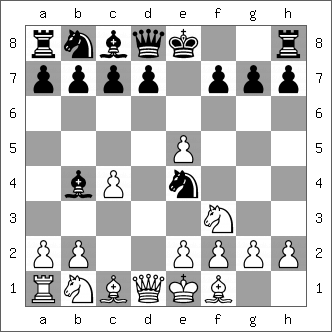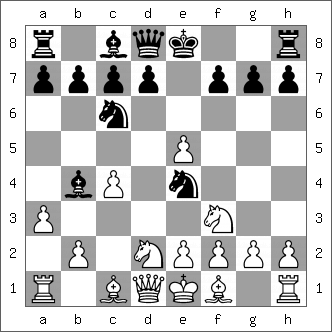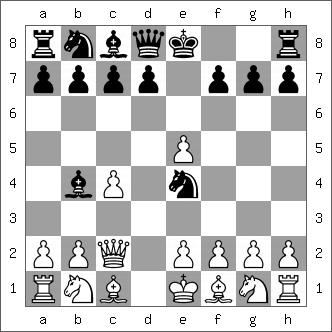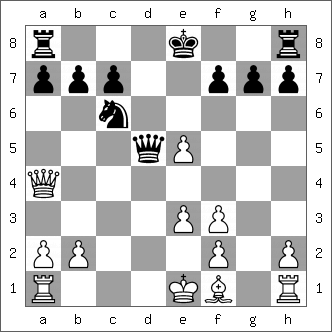This thread is presently the latest addition to my Junkyard Openings chesstalk threads series, which involves displaying my occasional attempts at rehabilitating suspect openings. The opening examined in this post is one that I've actually played many games with, mainly as Black, whether in tournament or casual chess. For chesstalk purposes I'll put forward a relatively small number of variations that may or may not prove critical for attempts at improving its reputation.
After the moves 1.d4 Nf6 2.c4
(instead 2.Nf3 Ne4!? [edit: the Dory Defence] is an old line, played even by Keres, that gains little attention from the books these days [edit: another possible 'matching' defence with the Budapest after 2.Nf3 is 2...c5 hoping for 3.d5 e6 4.c4 {or 4.Nc3 b5!?} 4...b5 transposing to the Blumenfeld])
2...e5!? 3.dxe5 Ne4!? we reach the starting point of the Fajarowicz Variation.
[edit: Note the little explored 3...Bb4 ch!? may also be worth investigating.]

Now I'll just look at White's three main choices:
1) 4.Nf3 (4.Nd2 Bb4 [4...Nc5!?] can transpose)
4...Bb4+ (4...d6!? has been played)

5.Nbd2 (5.Bd2 Nxd2 6.Nbxd2 Nc6 and if 7.a3, 7...Bf8!? has been played)
5...Nc6 (5...f6!? and 5...d6!? have been tried)
and after 6.a3

6...Bxd2+ (6...Nxd2 7.Bxd2 Bxd2+ 8.Qxd2 is known to favour White)
7.Bxd2 (or 7.Nxd2 Nc5!?),
now 7...Qe7!? has been tried, and it may be okay for Black.
2) 4.a3 may best be met by 4...d6!?, which is seldom mentioned in modern books, when a classic trap occurs after 5.exd6 Bxd6

6.Nf3?? Nxf2! and if 7.Kxf2 Bg3+ when White loses his queen.
3) 4.Qc2 Bb4+

5.Nd2 (5.Nc3 d5 6.exd6 Bf5 7.Bd2 Nxd6 8.e4 Bxc3 9.Bxc3 Bxe4 10.Qd2 0-0 11.0-0-0 Nd7= MCO-15)
5...d5 6.Nf3 Nc6 7.e3

7...Bg4 (7...Bf5 can lead to drawish simplification)
8.cxd5 Bxf3 9.gxf3 Nxd2 10.Bxd2 Qxd5 11.Bxb4 Nxb4 12.Qa4+ Nc6

and now if 13.Bg2 (+/= ECO) 13...0-0 (= Fritz), or 13.Bb5!? (Trapl) 13...0-0 and after 14.Bxc6 bxc6 15.Qe4 Qa5+ 16.b4 Qa6 Black has at least some compensation for his pawn.
After the moves 1.d4 Nf6 2.c4
(instead 2.Nf3 Ne4!? [edit: the Dory Defence] is an old line, played even by Keres, that gains little attention from the books these days [edit: another possible 'matching' defence with the Budapest after 2.Nf3 is 2...c5 hoping for 3.d5 e6 4.c4 {or 4.Nc3 b5!?} 4...b5 transposing to the Blumenfeld])
2...e5!? 3.dxe5 Ne4!? we reach the starting point of the Fajarowicz Variation.
[edit: Note the little explored 3...Bb4 ch!? may also be worth investigating.]
Now I'll just look at White's three main choices:
1) 4.Nf3 (4.Nd2 Bb4 [4...Nc5!?] can transpose)
4...Bb4+ (4...d6!? has been played)
5.Nbd2 (5.Bd2 Nxd2 6.Nbxd2 Nc6 and if 7.a3, 7...Bf8!? has been played)
5...Nc6 (5...f6!? and 5...d6!? have been tried)
and after 6.a3
6...Bxd2+ (6...Nxd2 7.Bxd2 Bxd2+ 8.Qxd2 is known to favour White)
7.Bxd2 (or 7.Nxd2 Nc5!?),
now 7...Qe7!? has been tried, and it may be okay for Black.
2) 4.a3 may best be met by 4...d6!?, which is seldom mentioned in modern books, when a classic trap occurs after 5.exd6 Bxd6
6.Nf3?? Nxf2! and if 7.Kxf2 Bg3+ when White loses his queen.
3) 4.Qc2 Bb4+
5.Nd2 (5.Nc3 d5 6.exd6 Bf5 7.Bd2 Nxd6 8.e4 Bxc3 9.Bxc3 Bxe4 10.Qd2 0-0 11.0-0-0 Nd7= MCO-15)
5...d5 6.Nf3 Nc6 7.e3
7...Bg4 (7...Bf5 can lead to drawish simplification)
8.cxd5 Bxf3 9.gxf3 Nxd2 10.Bxd2 Qxd5 11.Bxb4 Nxb4 12.Qa4+ Nc6
and now if 13.Bg2 (+/= ECO) 13...0-0 (= Fritz), or 13.Bb5!? (Trapl) 13...0-0 and after 14.Bxc6 bxc6 15.Qe4 Qa5+ 16.b4 Qa6 Black has at least some compensation for his pawn.


Comment